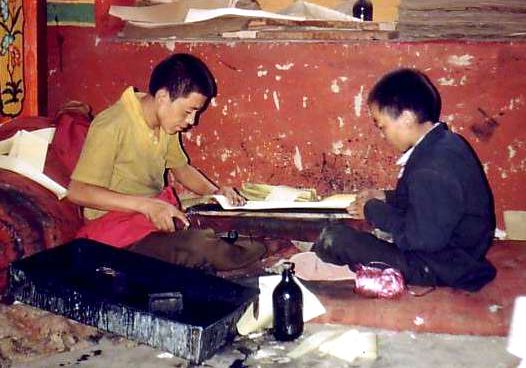Tibetan བཀའ་འགྱུར Traditional Chinese 甘珠爾 Hanyu Pinyin | Wylie bka' 'gyur Simplified Chinese 甘珠尔 | |
 | ||
The Tibetan Buddhist canon is a loosely defined list of sacred texts recognized by various schools of Tibetan Buddhism, comprising the Kangyur or Kanjur ('The Translation of the Word') and the Tengyur or Tanjur (Tengyur) ('Translation of Treatises').
Contents
The Tibetan Buddhist Canon
In addition to earlier foundational Buddhist texts from early Buddhist schools, mostly the Sarvastivada, and Mahayana texts, the Tibetan canon includes Tantric texts. The last category is not always sharply distinguished from the others: the tantra division sometimes includes material usually not thought of as tantric in other traditions, such as the Heart Sutra and even versions of material found in the Pali Canon.
The Tibetans did not have a formally arranged Mahayana canon and so devised their own scheme which divided texts into two broad categories, the "Words of the Buddha" and later the commentaries; respectively the Kangyur and Tengyur. The Tengyur underwent a final compilation in the 14th Century by Bu-ston (1290–1364). Unfortunately, we have no proof that Bu-ston also took part in the collection and edition of the Tsal pa Kangyur, but he consecrated a copy of this Kangyur 1351 as he visited Tshal Gung-thang (Eimer 1992:178). We know from sakya mchog ldan (1428-1507) that Bu-ston edited a Kanjur; unfortunately not which one. "The Kangyur usually takes up a hundred or a hundred and eight volumes, the Tengyur two hundred and twenty-five, and the two together contain 4,569 works."
The Kangyur is divided into sections on Vinaya, Perfection of Wisdom Sutras, other sutras (75% Mahayana, 25% Hinayana), and tantras. It includes texts on the Vinaya, monastic discipline, metaphysics, the Tantras, etc. Some describe the prajñāpāramitā philosophy, others extol the virtues of the various Bodhisattvas, while others expound the Trikāya and the Ālaya-Vijñāna doctrines.
When exactly the term Kangyur was first used is not known. Collections of canonical Buddhist texts existed already in the time of Trisong Detsen, the sixth king of Tibet, in Spiti, who ruled from 755 until 797 CE.
The exact number of texts in the Kangyur is not fixed, each editor takes responsibility for removing texts he considers spurious, and adding new translations. Currently there are about 12 available versions of the Kangyur. These include the Derge, Lhasa, Narthang, Cone, Peking, Urga, Phudrak, and Stog Palace versions, each named after the physical location of its printing. In addition some canonical texts have been found in Tabo Monastery and Dunhuang which provide earlier exemplars to texts found in the Kangyur. All extant Kangyur appear to stem from the Old Narthang Monastery Kangyur. The stemma of the Kangyur have been well researched in particular by Helmut Eimer.
The Bön Kangyur
The Tibetan Bön religion also has its canon literature divided into two sections called the Kangyur and Tengyur claimed to have been translated from foreign languages but the number and contents of the collection are not yet fully known. Apparently, Bön began to take on a literary form about the time Buddhism began to enter Tibet. The Bön Kangyur contains the revelations of Shenrab (Wylie: gShen rab), the traditional founder of Bön. A version was published in 1993-1997.
